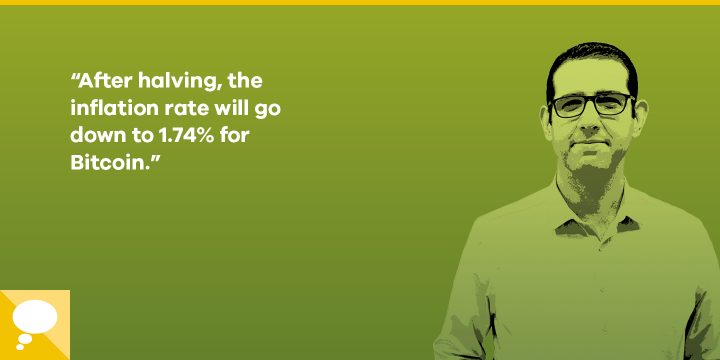
There is now very little time left for the bitcoin mining reward halving. Considering the average block resolution speed, it is expected that the halving will happen in the evening on May 11th, 2020.
Akar Aydemir
Paribu Business Development Manager
What is block reward halving?
Bitcoin became a part of our lives with an article which was published with the pseudonym Satoshi Nakamoto and had a big influence. The first blocks were mined by Satoshi Nakamoto on January 3rd, 2009. It took more than 11 years to mine approximately 630,000 blocks.
In the course of 2008 crisis, what was aimed with Bitcoin was to regulate inflation definitely. Therefore, reward halving was designed. In 2009, the reward started with 50 BTC per block. The plan was to halve it once every 210,000 blocks, and in this way the total bid would be 21 million by 2140.
- The first halving happened on November 28th, 2012 and the second happened on July 9th, 2016. The rewards first decreased to 25 BTC, then to 12.5 BTC.
- As a result of the halving which is expected to take place on May 11th with the addition of 630.000th block to the chain, the reward will be reduced to 6.25 BTC. It is foreseen that mining reward will be removed de facto in 2140.
The annual inflation for Bitcoin is 3.9% with the current reward amount, but after the halving this rate will go down to 1.74%. In this way, Bitcoin will reach an inflation rate even below 2%, which is the targeted rate by central banks of developed countries.
What can we expect from halving?
Halving is completely a technical matter, but based on the assumption that the value of the decreasing asset will increase, it is being seriously followed by investors. That a decrease in supply will decrease the sales pressure in price, is, yes, realistic. However, its effect on the price might be less than imagined.
- According to CoinMarketCap data of the last 30 days, 3 to 6 million Bitcoins are exchanged among all transaction pairs a day in cryptocurrency trading platforms. An average of 1800 BTC is created a day with the applicable block reward. After the halving, daily generation will decrease to 900 BTC.
- The real effect of halving will be shaped with the behavioral pattern of miners. One of the most important issues for the health of the Bitcoin network is the total processing power of the machines in the network, which is also known as “hash rate”. The more the number of mining devices, the higher the “hash rate”. “Hash rate” has a direct influence on the block generation time and level of difficulty.
- This time there will be a one-week gap between the halving and the difficulty upgrade that takes place once every two weeks. In other words, following the Bitcoin algorithm halving, the difficulty level will remain the same as it formerly was for the first week and no rapid action will be taken against the changes in the processing power. This might cause some delays in the confirmation of transfers by the network for the first week.
- As the block reward reduces, the changed generation cost might lead some machines to close down or go on working based on the machines’ own conditions. A great majority will have to upgrade their devices to adjust to the changed conditions. The dynamism here will cause certain oscillations both in the total processing power of the network and block generation time.
- However, when the difficulty level is set at the end of one week, the deviations will be replaced by balance. Thus, the algorithm, which has uninterruptedly worked for 11 years, will yield the expected result.
- Before and after the previous mining reward, the sharp oscillations in Bitcoin prices were seen to be offering important advantages. This obviously caused some investors to think that history will repeat itself. The important point here is that it is always the market that sets the price, and the market we are talking about is now far more participatory than it was in 2012 and 2016.
- Today, the trading volume, the number of investors and the diversity of products on the market are all much more than they used to be in the past. Therefore, it should be considered that the conditions of every halving are different.
The long-term impact of reward halving
The pressing effect of halving on inflation will continue until 2140.98% of the total supply will have been completed by the 2030s.
So, why should miners continue to approve transactions when Bitcoin decreases to such an extent? What will the incentive be? The answers to these questions lie within transaction fees.
Transactions fees are charged now, too. However, the reward is so encouraging that transfer fees are not being discussed that much. Based on the current statistics, this causes transfer fees to remain below 10% of the total mining income.
- It is expected that transfer fees will gain importance as the reward gets less and less encouraging.
- To put it differently, as the mining reward decreases, both the transfer fees and the share of transfer pees within the total mining income will increase.
- Again the competition of machines will act as the equilibrant here. Yes, the reward will decrease. However, the transaction fees which are expected to increase will get back to a reasonable level close to the cost of generation that occurs at the end of the competition.
Reward halving is a technical issue, but when the matter of question is an iconic cryptocurrency that is completely based on technology, price and technique get intermingled a lot.
It is certain that there will be many more new developments until the next block halving. Actually, the third block halving of Bitcoin has already started to create the statistics that we will be talking about in the future.
Bu içerik en son 26 October 2022 tarihinde güncellenmiştir.
